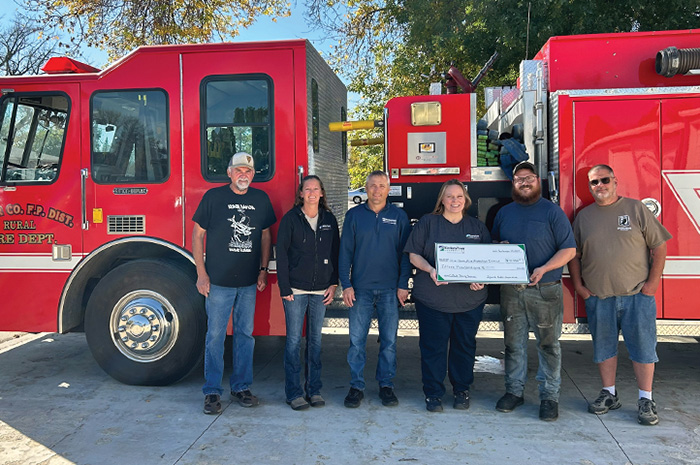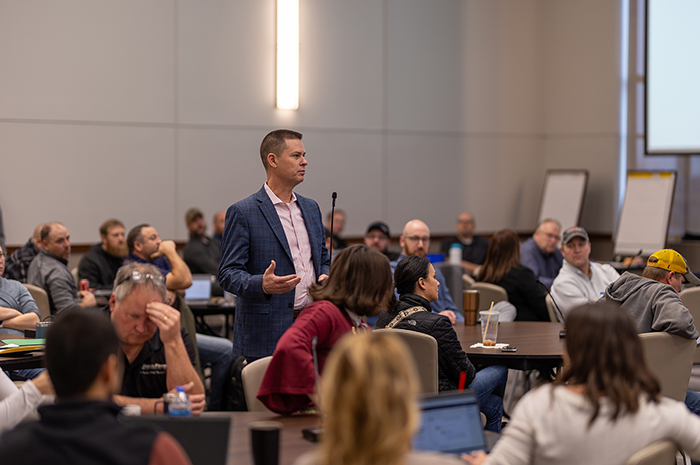Pecking disorder
A transmission line rebuilt by Minnkota Power Cooperative will be protected from woodpecker-caused challenges.
There’s a sharp rat-a-tat that rings through the trees in Lake of the Woods County and it’s been giving Minnkota’s power delivery personnel headaches for decades. Generations of the area’s woodpeckers have hollowed out their homes in the cooperative’s wooden transmission poles, requiring ongoing maintenance along a 40-mile stretch of line from Warroad to Baudette, Minn.
But a new structure design and stronger material could serve as a sort of aspirin for the long-suffering engineers and lineworkers who have toiled to repair and replace structures the birds have carved up with precision. For the first time on Minnkota’s system, ductile iron is being used in place of wood to rebuild a 69-kilovolt (kV) transmission line.

“Sometimes, it feels like the woodpeckers are building condominiums in our poles,” joked Mark Thorson, area lineworker stationed along the Canadian border. “We’ve put wire mesh up to try and protect everything, but if they’re determined, they can peck right through it.”
The tiny birds can do a huge amount of damage. In many instances, their mini-jackhammering can turn an otherwise sturdy pole into Swiss cheese – creating risks of the line falling down, power outages, fires and the safety of both the lineworkers and area wildlife. In addition to preventing pecking problems, the region’s power delivery infrastructure is susceptible to an assortment of critters, ants and water issues.
“Bears can be another huge problem up here,” Thorson said. “A lot of the time, we find them scratching on the poles and causing all kinds of damage.”
Several poles have been repaired or replaced since the 69-kV line was put into service in the late 1940s. But with the line scheduled for complete rebuild this summer, Minnkota’s engineering team went outside their normal design specifications. The iron material carries a higher cost, but it is anticipated that there will be long-term savings through less maintenance required.
“This is the same basic material that’s used to make water piping, so it will last a long, long time,” said John Thompson, lead engineer on the first half of the project, which was completed this fall. “This line has been in service for almost 80 years, and we want to get another 80 years out of this new line.”
Thompson credited Minnkota member North Star Electric Cooperative with helping ensure the construction process on his part of the project went smoothly. The second half of the line construction is under way and scheduled for completion in mid-2023.

“North Star has been great to work with on this project,” Thompson said. “They helped us store material, coordinated the underbuild (distribution line under the transmission line) projects and helped set up outages so we could safely complete our work.”
Although the woodpeckers have been a nuisance, Minnkota went to great lengths to ensure their nesting habitat wasn’t negatively impacted during construction. As part of the cooperative’s Avian Protection Program, detailed inspections were conducted to ensure the protection of the region’s bird population.
Last of the copper
While the northern Minnesota wilderness dictated some of the project design elements, the major driver for the rebuild work was the age, condition and antiquated hardware components on the transmission line. The line’s original copper conductor (wire) was replaced with aluminum wire, which allows for much greater operational flexibility.
“This was the last remaining copper conductor on the Minnkota system,” said Skylar Ertman, lead engineer on the second half of the project. “With the new conductor and improved structure design, members in the region should see improved reliability.”
At an average height of 60 feet, the new standard 69-kV transmission structure in the Minnkota system is about 20 feet taller than the original structures. It includes a static wire to protect from lightning strikes, which are a major cause of blink power outages, and a fiber-optic ground cable, which will enhance Minnkota’s communication capabilities in the region.
Rebuild program improving reliability
Over the last five years, Minnkota has rebuilt about 100 miles of 69-kV transmission line across its service area. In addition, more than 1,300 miles of line have been equipped with technologies to reduce blink outages.

And transmission lines aren’t the sole focus. Substations are getting the rebuild treatment, too. This year, two aging distribution substations – Finley (N.D.) and Tabor (Minn.) – have been rebuilt and the Rogers (N.D.) rebuild project began this fall. Minnkota budgets to complete two to three substation rebuild projects annually.
The newly constructed substations provide an updated design and significant benefits in terms of communication and reliability. An upgraded computer system, known in the industry as SCADA, will help gather and analyze data, while also monitoring and controlling equipment processes remotely. With access to real-time data, operators can more quickly identify system issues and potentially reduce outage time.

The investment and effort have produced results. Minnkota is experiencing significantly fewer sustained outages and blink outages per delivery point. Those numbers should continue to improve as Minnkota’s programmatic approach to addressing aging infrastructure helps make the power delivery system smarter, stronger and more efficient.
“We still have a lot of aging infrastructure on our system,” Ertman said. “But we’re making progress and starting to see real results.”
MAIN IMAGE: Minnkota’s new 69-kV transmission line from Warroad to Baudette, Minn., was built using ductile iron to protect against woodpeckers and other impacts.
...



